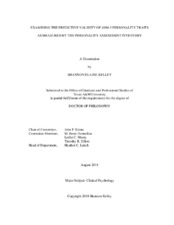| dc.description.abstract | The prevailing categorical system of classifying personality disorders in the Diagnostic and Statistical Manual of Mental Disorders (DSM-5) demonstrates serious weaknesses in conceptual precision and clinical utility. To address the disadvantages of this approach, the DSM-5 Personality and Personality Disorders Work Group developed an alternative model for personality disorders (AMPD) that focuses attention on 25 pathological personality traits, which are organized into five maladaptive domains of personality. By assessing symptom severity from a transdiagnostic personality trait perspective, the AMPD provides valuable information about individual functioning that might be absent from or obscured by the current criterion-based nosology of personality disorder.
The AMPD was ultimately incorporated into the DSM-5 Section III as an emergent conceptualization with the goal of stimulating further empirical inquiry. This has generated a number of developments, including proposed strategies for assessing the AMPD pathological trait facets and domains using the Personality Assessment Inventory (PAI). The purpose of the present study was to cross-validate these new measurement strategies in an offender sample and demonstrate how they can be effectively applied to promote and refine the AMPD, particularly with respect to operationalizing antisocial personality disorder (ASPD) and psychopathy. Findings suggest that the PAI DSM-5 scoring strategies provide comprehensive coverage of AMPD pathological traits, and are comparable to measures intentionally designed for this purpose.
The resulting personality dimensions converged in theoretically consistent ways with criterion measures assessing ASPD and psychopathic features, psychological dysfunction, and future problems with institutional adjustment, criminal activity, and treatment compliance. Beyond assessing the core personality characteristics and consequences of ASPD at least as well as the original PAI Antisocial Features scale, PAI DSM-5 pathological traits were particularly useful in capturing psychopathic features that are not well represented by any one existing scale or subscale of the instrument (e.g., fearless dominance). However, adjustments to the DSM-5 AMPD psychopathy specifier might contribute to a more precise and complete conceptualization of the construct. Overall, this study was successful in showcasing one of many ways in which the PAI and DSM-5 AMPD can work together to advance personality assessment, shape diagnostic criteria, and expand our understanding of psychopathology. | en |


